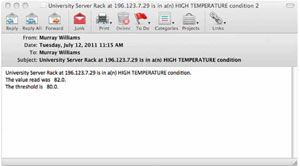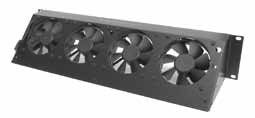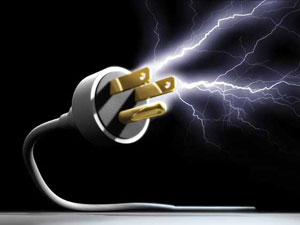Protecting Current Investments Sparks Future Business
Racy, sexy, and glamorous. Or not. “Selling and integrating power and energy management might not be the sexiest or most exciting component of a system spec, but it is one of the most important,” said Panamax/Furman director of marketing, John Benz. “With power management, the common analogy is insurance. Proper protection and noise filtering insures the system against failure from an uncontrolled variable, namely, the incoming power.”
In a region such as the southeastern U.S. where lightning is so common that a catastrophic power event is an almost everyday concern, the client will likely be very receptive to this, he elaborated. “It’s important to remember that power management is not all about lightning. In fact, most spikes and surges aren’t caused by lightning or an outside source, but instead from equipment such as compressors, generators, pumps, etc. turning on and off within a facility.”
When AV gear is subjected to these small disturbances as often as dozens to hundreds of times a day, the cumulative wear and tear on sensitive circuitry leads to shorter life spans, increased downtime, and more service calls. “Removing distortion from the AC line with proper line conditioning, regulating the incoming voltage to ±5V of 120V, and isolating AV components from other equipment can all be part of a proper point-of-use AC power management solution, depending on the power quality at the install location,” Benz said.
Among other trends, SurgeX’s Shannon Townley said, “I’m starting to see a lot of interest in our NEMA products coupled with energy management and green AV. We’re starting to put most of our development there, and are moving toward being connected and being able to give end-users/tech managers valuable data on energy consumption/ microclimate reporting.”
The power factor ratio has become big; an equation providing a factor between zero and one. “If the power factor is 0.5 you are only 50 percent efficient,” Townley explained. “System users want a quick measurement and they want to be able to look at historical data.”
It’s key that the integrator show real value in their recommended protection solutions, said Murray Williams, product manager, electrical/electronic at Middle Atlantic Products. “Without it, they will have a difficult time persuading the customer that it’s worth spending the money. Clients realize that it’s necessary to protect their investment, but many feel that the initial investment should provide system protection to begin with.”
Any proposed solution has to provide a broad swatch of benefits in order to maximize the client’s current investment, he elaborated. “That means it should be as encompassing as possible to include an open architecture integration protocol allowing said solution to be integrated seamlessly with existing architecture while not imposing any unnecessary overhead on that system.”
Middle Atlantic is in the beta phase for RackLink, a new power and energy management solution that monitors and proactively alerts on breaches to heat, load current, and voltage thresholds, and offers extensive monitoring capabilities for additional assets including thermal load (BTU s) and power factor.
“This gives the integrator the means to proactive energy savings and supports both IP and RS-232 interfaces,” Williams observed. “Each device also has a local web server that allows access through a browser, so there are three ways to interface. It also offers proactive email notification for over- or under-voltage, current, and thermal conditions and provides the means for eventbased actions on environmental anomalies. If an over-temperature condition is detected, for example, we can automatically turn fans on or off or close a contact and send out emails to the integrator.”
Primarily targeted for commercial AV projects, RackLink will be introduced at CED IA 2011 because of its open architecture and a seamless integration for residential control system environments allowing additional value, he said. “The initial RackLink focus will be on green initiatives, making this a very appealing solution for commercial AV or for any application that proactively logs, notifies, and alerts when there are environmental anomalies or energy consumption thresholds. This includes stadiums and campuses where the geographical footprint is vast and where it becomes impractical to have local server rooms in each location. It’s a lot cheaper to run Cat-5 than to have a staff member visit.”
What’s happening now is a fusion between the integrators and IT, noted Dennis Mariasis, AV business development/brand manager, Tripp Lite. “The most important thing for integrators to understand is how to include more IT relational information within their installations. If an integrator stays in the old world of analog he will be surpassed by the new generation who are embracing IT/digital protocols.
“Some small old-school guys are going to digital while kicking and screaming. For them it once was easy; if you had good eyes and ears you were a god to your client. Now you have to be an IT professional to be able to control these systems. It’s about being intelligent and understanding how to put a system together using IT protocols.”

Proactive notifications, such as this email example from Middle Atlantic Products’ new RackLink system, alert owners or installers of dangers to the installed AV equipment. The RackLink system can also be programmed to take protective action immediately, such as triggering additional fans or powering down equipment.
Systems built in an analog world could handle anything, including “weird” voltages, he noted. “Ben Franklin could not have fathomed that electricity would be used for more than lighting up a carbon filament. Now we’re putting demands on electrical grids, which in turn affects circuit boards no bigger than a fingernail. We need to pay attention to how we protect electronics. Digital is beautiful but with it comes sensitivity.”
To that end, Tripp Lite has introduced three Pure Sine Wave / Double Conversion UPS systems, the HTR 10-2U, HTR 15-2U and the HTR 22-3U. “The Pure Sine Wave series power plant provides the very best in EMI/RFI harmonic filtration along with surge/ spike protection and offers a zero transfer time to battery power unlike all the other UPS systems with AVR which have a two- to eight-millisecond delay,” Mariasis explained. “No matter what’s happening with the voltage on the input side, the output is always a clean, pure sine wave—24/7. This will also give your equipment longer life spans, which helps keep these products out of the landfill.”
Energy management holds tremendous promise, Benz said. “The market has not matured as quickly as most were predicting, and many integrators have become disenchanted with the concept of energy management, with good reason: there’s little demand from their clients, there’s little hardware available (only a lot of vaporware), and most of the solutions that are available are too expensive for a client to be interested in.”
This scenario is changing, however. “A major demand driver is currently being put into place: utilities are changing billing structures to time-ofuse (TOU ) billing to reduce peak demand on the grid,” he explained. “This is a prime motivating factor behind the smart grid infrastructure overhaul in the U.S.”
In the next few years, terms like “on-peak,” “off-peak,” “demand response,” and “price signaling” will become part of our vernacular. “TOU pricing, which enables higher electricity billing during peak demand times of day instead of a traditional flat rate or tiered structure, is already in place by dozens of utilities,” Benz said. “With 60 million smart meters expected to be deployed by 2020, TOU will likely be the prevailing billing method in the next few years.”
The purpose of TOU pricing is to change consumer behavior and lower demand on the grid during peak hours. Faced with unsustainable projected energy demand, utilities are “load shedding” by punishing customers with higher rates for using electricity during high-demand hours such as between 12 p.m. and 6 p.m. on weekdays, and incentivizing customers with lower rates and/ or rebates for use during off-peak hours, he explained.
“For the integrator, this makes understanding their equipment’s consumption, stand-by power, energy monitoring, and automation technologies to reduce waste all the more important. These changes present a challenge and an opportunity for integrators. Integrators will need to learn and understand what is happening with our energy infrastructure and the solutions available on the market in order to be able to help clients navigate through the smart grid upgrade.”
Once armed with this understanding and the ability to integrate energy-saving technology, Benz noted, integrators have the opportunity to ride a new wave of demand in electronic systems by adding energy auditing and energy usage optimization to their service portfolios. This demand will be driven by substantial spikes in electric bills for utility customers that do not understand or abide by their new billing structures.
Commercial integrators will need to be first to the party, he added. “Because of their relative high energy use, commercial customers are a priority for utilities. For example, PG&E in Northern California has rolled out TOU schedules for its commercial customers while maintaining tiered rates on residential customers. InfoComm’s STE P Program and CED IA’s Sustainable Lifestyles Initiative are currently putting together education to assist integrators in navigating this brave new world of energy management, and manufacturers are providing a wider variety of solutions to monitor and control energy use.”
Benz pointed to Panamax/ Furman’s BlueBOLT platform providing AV systems with cloud-based energy monitoring, allowing integrators and their clients to view energy consumption in real time or over history. “Energy budgets can be set up and email alerts can notify the integrator or client when a system is reaching or exceeding its allotted energy budget. Importantly, BlueBOLT goes a step further by providing full energy control and automation. By enabling remote control of power outlets on compatible Panamax/Furman hardware, integrators can schedule conservation commands to eliminate standby power during non-use or on-peak hours, in addition to the major benefit of allowing integrators to hardreboot locked-up components without a service call.”
And although end-users may not understand or care about the varying types of protection, they are willing to pay for it, Townley said. “The cost is still a pittance of the total install value. Given the sensitive nature of today’s AV equipment, a robust protection system serves as an insurance policy for both customer and integrator. It’s a matter of trust. As an integrator, the last thing you want to do is install a lowend solution.”
The segment is the last thing considered, Mariasis acknowledged. “But it’s about protecting the foundation. All you need is for the electrical system to spit out a power anomaly to ruin your hard work. Power is not glamorous and no one thinks about us. They think about the cool controls and lighting. We’re the unsung heroes in the system. The best part about selling these products is to tell your client you are building the system on the best foundation possible.”
Margin Builder
“It’s important to make sure your client understands that transient energy is real,” emphasized Shannon Townley of SurgeX. “A power failure doesn’t have to be caused by a lightning strike; the problem can come from within the same building. At the end of the day they’re spending all this money on an AV system, and when they buy the right tools and write the check that first time they only cry once.”
Karen Mitchell is a freelance writer based in Boulder, CO.
Monetize It
Power protection is the last frontier where integrators and dealers make money. “Everybody has to plug in somewhere, and because of that integrators need to keep their credibility with customers,” observed Shannon Townley of SurgeX. “This is high-dollar equipment requiring good protection. If it’s positioned properly on the sales side, there is money in power protection.”
Energy management is a relatively new category that requires a different sales approach, noted Furman’s John Benz. “While power management can be associated to insurance, energy management is more of an investment, with a measurable return over time due to cost savings. Energy management has the potential to be a very easy sale if the integrator is able to demonstrate this return on investment.”
Over the next few years, he said, we will see growing demand, education, and hardware solutions for AV energy management. “Consultants and integrators that are armed with the knowledge and tools to properly audit energy use of their installed systems during specification, that specify low-energy components, and that include energy monitoring/control solutions, provide a substantial level of value to their clients from both a product and a service perspective. Forwardthinking integrators that install monitoring/automation solutions now can ensure their clients will not be calling them back in the next 12 months when their utility switches them to TOU billing and they need to understand where the on-peak energy usage is coming from, or they require a solution to eliminate the stand-by power of their installed system.”
Your past clients are your best clients, advised Dennis Mariasis of Tripp Lite. “There’s a lot of opportunity to go back to customers, which is often forgotten. You can do a service check to see what’s going on with their power grids, especially given local weather conditions. This gives you a good reason to see it all. You can introduce the client to some double conversion pure sign wave UPSs to make sure whatever happens at the wall socket is never seen by equipment. What we do is not that expensive and gives a clean bill of health. Use the service call to create some additional business.”
The secret to monetizing is in making the customer aware that these systems exist and by reinforcing the reality that commercial and residential AV is becoming part of the network domain, said Middle Atlantic’s Murray Williams. “You can’t purchase anything without a network port and customers are becoming more cognizant that it’s a part of their lives and that solutions can greatly benefit the end users. “
—K.M.
Keep Your Cool

Any conversation about power and today’s digital electronics must also take thermal issues into consideration.
“When it comes to cooling, it’s not an accessory item, it’s a necessity,” noted Ron Linder, product manager for Cool Components. “There are a countless number of electronic products out there that we can’t live without, and they generate so much heat that you need to do everything you can to make them last as long as possible. And cooling is probably one of the most important things to do that.”
Better cooling can improve a client’s return on investment, as well. “You can increase the life of your product dramatically if you can keep it cool,” Linder said. “If you look at a lot of the manufacturer’s recommendations for the space around most electronic components, it’s almost impossible to keep equipment ventilated naturally. That’s why some kind of active cooling is definitely necessary.”
Cool Components’ contribution to the thermal management product marketplace includes the Universal Cool CP-UC and CP-UC-2. Good for spot-cooling or venting (intake or exhaust) racks, cabinets, recessed TV enclosures, etc., these 1RU and 2RU options can be mounted in the front or back of a rack or even wall-mounted. The CP-UC features six fans and the CP-UC-2 features four fans. All fans are mounted using special mounting hardware, which eliminates noise. The units operate on DC voltage and by adjusting the voltage, the unit can run silently or more aggressively depending on the application. The fans can also be reversed and the unit oriented to blow air either upward or downward.
—Kirsten Nelson










